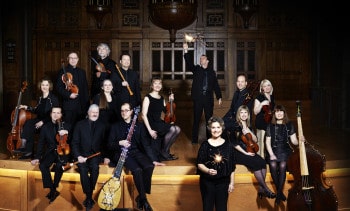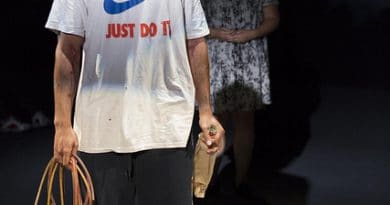Adelaide Festival: House Of Dreams

Delicate, rich, genteel, were all words which immediately came to mind the moment this extremely talented and accomplished band started playing on their period instruments, with the majority of the players arriving from the aisles. Starting their national tour for Musica Viva’s 70th anniversary in Adelaide as part of the Festival of Arts, this fine Canadian 17 piece baroque orchestra held a packed Town Hall audience spellbound as they played a feast of baroque music against a changing cavalcade of exquisite images of paintings from the period and the houses in which the music was written or performed by the composers and musicians of the day.
House of Dreams juxtaposes the music with the paintings which were projected on to a huge gilt-framed screen behind the musicians, who moved around the stage, playing with precision and polish. With the heightened sensitivity demanded by playing with neither conductor nor scores, the orchestra achieved an extraordinary sense of ensemble, as the musicians played to each other as if in a conversation, as was implied by the music, particularly apparent in the Allegro from Handel’s Concerto Grosso in D.
The houses, all still in existence, in Venice, London, Paris, Delft and Leipzig were represented in photographs and in paintings which hung on their walls at the time of this gorgeous music. Handel himself owned some 80 paintings, and his Entrance of the Pleasant Dreams from his opera Alcina, against a Watteau painting inspired by the story, was one of the many apposite juxtapositions that made this concert so special.
Other paintings featured included works by Canaletto, Breughel the Elder, Rembrandt, Marco Ricci, Vermeer, and the set painter who worked with Handel, Antoine Watteau.
A well-known Canaletto painting of Venice heralded a collection of excerpts from Vivaldi concertos with more Venetian scenes, which transported us to the city itself. Then Vermeer, including three of his famous faces, took us to Delft, and to the music of Sweelinck and Henry Purcell.
[pull_left]The concept of this multi-media presentation is brilliant[/pull_left]
In the second half we “visited” Marin Marais in Paris, and his Suite from Alcyone . Next to Leipzig and the King of the baroque, Johann Sebastian Bach, where we were treated to three of his works, including the Largo for two oboes, played by John Abberger and Marco Cera, who showed how they can maintain perfect synchronicity whilst being on opposite sides of the stage. An energetic and exuberant rendition of the Allegro movement of Bach’s double violin Concerto in D followed.
Much of the credit for the musical part of this superb concept must go to the long-standing Director of the group, Jeanne Lamon, who subtly led the orchestra from the violin, showing how a group of seasoned professionals can bring out every nuance, maintain close eye contact and mutual attentiveness even as they move around, so that they achieve perfect unity in tempo changes, starting and stopping, without a conductor.
The concept of this multi-media presentation by Alison Mackay (who also played the double bass, and wrote the script and the comprehensive program notes) is brilliant. The intricacies shown by close-ups of some of the paintings emphasised the intricacies of the music, which in turn beautifully complemented the pictures.
The planned, yet smooth, informal and un-hurried movement of the musicians amongst each other, enhanced by the sympathetic lighting, allowed soloists to take the limelight, and complemented the ebb and flow of the music. The third dimension of the complex but perfectly ordered edifice that was this concert, was the well-researched, engagingly delivered commentary by Toronto actor Blair Williams. This added a level and a depth of understanding to both the music and the paintings, and tied the whole together into a transporting dance of auditory, visual and kinaesthetic sensation and delight.
Telemann, and a Handel encore rounded out a first class feast of superbly presented and enhanced music which left the audience begging for more. An emotional high could have been topped off if Adelaide audiences were not so staid and stuffy as to not burst into the spontaneous standing ovation that this performance deserved.

